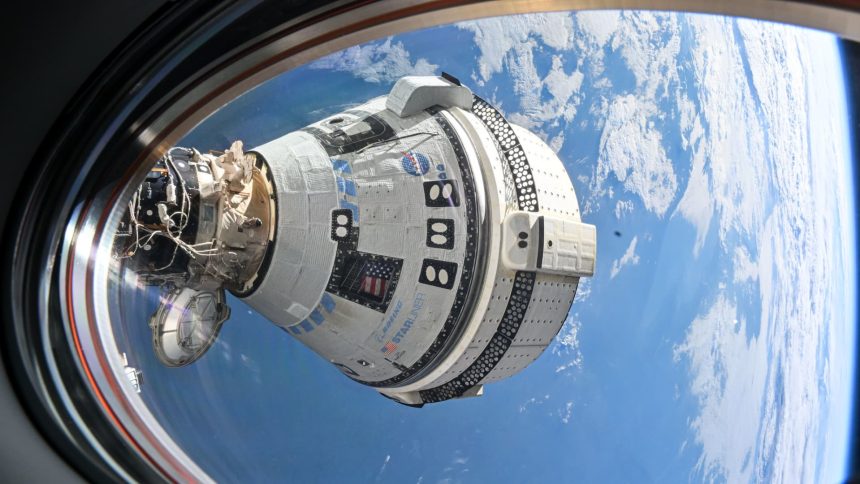NASA management has been in deep discussion this week about whether to return the agency’s astronauts on board Boeing‘s misfiring Starliner capsule or to go with the alternative of using a SpaceX craft to rescue the crew.
The agency’s concern with Starliner — which flew NASA astronauts Butch Wilmore and Suni Williams to the International Space Station in early June — comes from not having identified a root cause for why multiple of the spacecraft’s thrusters failed during docking, a person familiar with the situation told CNBC.
NASA this week has been discussing the possibility of returning Starliner empty and instead using SpaceX’s Crew Dragon spacecraft to return its astronauts. There is no consensus among those responsible for making the decision, that person said, calling the outcome of NASA’s ongoing discussions unpredictable given the variety of factors involved.
The Starliner capsule “Calypso” has now been in space 59 days and counting. The mission is intended to serve as the final step toward proving Boeing’s long-delayed spacecraft is safe to fly lengthy crew missions to-and-from the ISS.
The Boeing crew flight was initially planned to last a minimum of nine days. But it has been extended several times while the company and NASA conduct testing both back on the ground and in space in an attempt to understand the thruster problem.
While NASA and Boeing leadership have publicly characterized the extensions as a data-gathering exercise, the concerns raised in recent days reveal that there is less confidence internally on whether Starliner is safe to return the astronauts than the agency has disclosed.
Sign up here to receive weekly editions of CNBC’s Investing in Space newsletter.
Ars Technica first reported NASA’s mixed opinion on Starliner’s situation. NASA previously noted that SpaceX serves as a backup but has sought to deemphasize that possibility, calling Boeing’s spacecraft the “primary option” for return.
For its part, Boeing says it has the “flight rationale” to return Starliner with the astronauts on board, meaning the company believes the spacecraft can return without too much risk.
“We remain confident in the Starliner spacecraft and its ability to return safely with crew. We are supporting NASA’s requests for additional data, analysis and data reviews to affirm the spacecraft’s safe undocking and landing capabilities,” a Boeing spokesperson said in a statement to CNBC on Friday.
If Starliner returns empty, the most likely alternative would be to bring the astronauts back using SpaceX’s Crew Dragon by removing two astronauts from the Crew-9 mission — currently planned to launch four people in the coming weeks. That would open up two seats for Wilmore and Williams.
NASA did not respond to CNBC’s request for comment on the ongoing Starliner discussions, but told Ars Technica in a statement that the agency “is evaluating all options for the return.”
“No decisions have been made and the agency will continue to provide updates on its planning,” NASA said.
Trusting the thrust
After testing this past weekend, NASA noted that 27 of Starliner’s 28 thrusters appear to be healthy. The thrusters, also known as its reaction control system, or RCS, engines, help the spacecraft move in orbit.
But from an engineering perspective, not having a root cause for why five of the thrusters failed on the flight to the ISS means that risk remains for more thrusters to malfunction during the return flight.
Boeing’s Mark Nappi, vice president of the Starliner program, said during a press conference on July 25 that testing of the thrusters has resulted in “very significant” findings that “are likely the root cause.” But despite that, the company has not identified the root cause yet.
“We’re going to continue to take that hardware apart so that we can finally prove this,” Nappi said at the time.
NASA now needs to decide if it’s willing to trust that the unknown issue with Starliner’s thrusters does not arise again, or even potentially cascade into other problems.
An unpredictable outcome
NASA’s lack of consensus arose when the Commercial Crew Program Control Board met earlier this week to discuss Starliner’s return. PCBs are a standard part of NASA’s decision-making process, dating back to the Space Shuttle era, and are an effort to make sure any risks can be elevated to the highest levels of the agency’s authority.
The PCB, chaired by Commercial Crew program manager Steve Stich, did not come to a decision on whether to move forward with a flight readiness review, the next major agency step toward establishing a date for Starliner to return. The next PCB meeting is expected in the coming days, with NASA noting in a blog post on Thursday that return planning will continue into next week.
If any members of the PCB dissent on the decision to return Starliner with crew, the decision would go up the chain of command until the dissent is addressed. As it stands, the discussions within the PCB do not have a predictable outcome as NASA personnel discuss the level of risk involved on returning crew with Starliner.
Making a choice
NASA often emphasizes that “astronaut safety remains the top priority” for the agency in making decisions about human spaceflight, an inherently risky endeavor.
But the choice NASA faces has further ramifications, which threaten Boeing’s involvement in the agency’s Commercial Crew Program. Already, Boeing’s Starliner losses total more than $1.5 billion due to repeated setbacks and years of delays in developing the spacecraft.
If NASA backs Boeing and returns Wilmore and Williams on Starliner, the agency is accepting a currently unquantifiable amount of risk. A major failure during the return, with the astronauts’ lives at stake, would put NASA leadership under pressure to end Boeing’s contract and involvement in the program.
If NASA decides to send Starliner back empty, it’s a vote of no confidence in Boeing that may lead the company to cut its losses and withdraw from the program.
Additionally, if NASA takes the SpaceX alternative and Starliner returns home without incident, the agency faces blowback from being seen as overreacting to a situation that it publicly declared for weeks was not a significant risk.
Read the full article here




